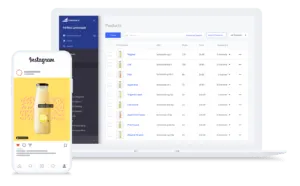Why Your Product Catalog is the Key to Social Commerce Success
Elizabeth Hudson

Billions of people use Meta Technologies every day to connect with family and friends worldwide, but these social commerce platforms have evolved into powerful sales channels.
Social commerce has become a new way to boost sales and reach new shoppers, giving them the option to purchase directly from those channels. It creates a smooth transition for consumers, which is why a high-quality catalog is necessary and imperative.
Detailed product information helps drive discovery and consideration but also improves the buyer experience. Product titles and descriptions are essential since it’s the first impression of your item.
Customers will have a better experience and build more trust with your business if the products they see in your Facebook and/or Instagram Shops are in stock and correctly priced. But in order to reach more people and drive more sales, merchants need to have a high-quality product catalog.
If you’re not already selling on Facebook or Instagram, here’s how to get connected.
What is a product catalog and why is it important?
A catalog holds information about the products you sell across Facebook and Instagram. The quality of your catalog product data is central to creating a positive shopping experience within ads and Shops.
Optimizing your catalog quality can help customers discover your items and make more informed purchase decisions.

Benefits of a high-quality catalog:
Improve your discoverability in search results: Therefore, the quality of your product directly impacts the likelihood of your product being discovered and giving you increased distribution.
Drive conversions: It’s essential to have consistency between your catalog and website. Not only do shoppers expect a seamless experience between channels, but enriching your catalog with visuals and detailed product information will ensure buyers have complete and accurate product information when it’s time to buy.
Best Practices
With so much opportunity available through Facebook for BigCommerce, merchants need to be strategic about creating optimal content that drives conversions.
Here are our best practices and top tips to help your brand stand out:
1. Use detailed product information.
Category-specific attributes not only help customers to discover your product, but they also improve the buyer experience and can help increase the chances for conversion. Different attributes serve different purposes:
Discovery: These attributes don’t appear directly on your product details page (PDP) however help buyers discover your product during search. Examples include brand, gender, and age group.
Variants: Provide variant attributes for all products where a product variation exists. Examples include color, material and size. Learn more on variants on the next page.
Consideration: These attributes appear directly on your product details pages as variant selectors and help buyers consider buying your product.
2. Manage product variants in your catalog.
Variants are variations of the same product in your catalog, such as the same T-shirt in different sizes or colors. Setting up variants properly in your catalog gives customers a better experience when they see your products in ads or Shop.
Adding variants allows you to:
Help customers find more colors, sizes, patterns or materials of a certain product.
Show people a wider selection by displaying one variant of each product in your shop. When people select the product to learn more, they can see the other variants.
3. Keep your catalog up to date.
You’ll need a product catalog to use product tags on Instagram, and having a robust one can help you be successful. Always consider the shoppers’ point of view: They see your post in their feed or discovery; they want to learn more and tap the image. They see the product tag and advance to the product detail page.
Important things to consider when updating your catalog:
Inventory: Only products with inventory can be sold. To start selling products, update your catalog with accurate inventory counts (so you know when items sell out) and product category codes (for taxes).
Product names: Keep product names concise and consistent with your website on Instagram, so shoppers can see how to utilize a product.
Product descriptions: Include the item description, including length, materials, cut and size considerations. For non-US sizes, remember to include size conversions.
Sizing: For products that need sizing consideration, make sure details are precise. If a product has multiple sizes, ensure you have inventory for each size. To add a size chart, refer here for more information.
Pricing: Make sure the price is accurate and consistent with your website.
Shipping Fees: You have the option to set different types of shipping fees, including free shipping minimums at various service levels. Put your shipping options in your Commerce Manager settings.
Pro Tip: Without more images or videos to swipe through on a product detail page, shoppers can easily churn so provide at least two photos of the product.
4. Use product tags frequently.
Every month, 130 million people tap on product tags to learn more about brands they see on Instagram. Product tags enable you to highlight products from your BigCommerce catalog and help customers learn more about what you’re selling.
Using product tags is essential for giving shoppers an easy way to find your brand, but also to make a convenient purchase. Product tags should be a part of your baseline Instagram strategy, and you should leverage them whenever posting images of products.
According to Facebook data, merchants that tag 5+ days per month on their feed, see on average:
278% increase in product page visits
231% increase in purchases
216% increase in sales
The most successful Shopping businesses use product tags frequently across different formats in feed, stories, Reels, IGTV, captions and Live because people spend time in different places on Instagram.
Using product tags consistently to create more shoppable posts can help you reach new shoppers and get the most out of your shop.
In short, your product catalog is central to your social commerce success. For more strategies, tips and success stories to help you thrive across Facebook and Instagram, check out our guide here.

Elizabeth Hudson is a Content Marketing Manager at BigCommerce, where she specializes in content strategy and writing on all things for omnichannel marketing. She previously worked at IBM, focusing on content and product marketing.


